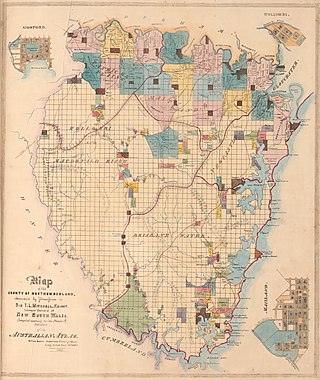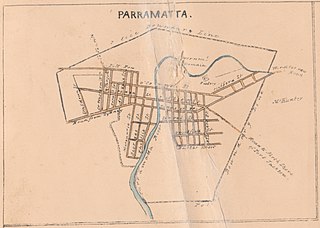Related Research Articles
William Bowman was an Australian politician and an elected member of the New South Wales Legislative Council between 1843 and 1856. He was also a member of the New South Wales Legislative Assembly for 1 term from 1856 until 1858.

The Electoral district of Town of Melbourne was an electorate of the New South Wales Legislative Council before it became part of the Colony of Victoria on 1 July 1851.
This is a list of members of the New South Wales Legislative Council from 1843 to 1851. The 1843 Electoral Act prescribed 36 members, 24 to be elected, 6 appointed by virtue of their office and 6 nominated. The appointments and elections were for five year terms and thus occurred in 1843, and 1848. The Speaker was Alexander Macleay until 19 May 1846 and then Charles Nicholson. The parliament was dissolved on 30 June 1851 as a result of the 1851 Electoral Act which increased the number of members in the Council to 54.

The Electoral district of County of Durham was an electorate of the New South Wales Legislative Council at a time when some of its members were elected and the balance were appointed by the Governor. It was named after Durham County, which lies on the north side of the Hunter River.

The Electoral district of County of Cumberland was an electorate of the New South Wales Legislative Council at a time when some of its members were elected and the balance were appointed by the Governor.
This is a list of members of the New South Wales Legislative Council from 1851 to 1856. The 1851 Electoral Act increased the number of members in the Council to 54, 18 to be appointed and 36 elected. The initial appointments were made in October 1851. The Speaker was Charles Nicholson.

The Electoral district of Counties of Gloucester, Macquarie, and Stanley and from 1851, Gloucester and Macquarie, was an electorate of the partially elected New South Wales Legislative Council, created for the first elections for the Council in 1843. The counties of Gloucester and Macquarie were the settled coastal areas north of Northumberland County, while the County of Stanley was the area surrounding Brisbane, in what became part of Queensland after its separation in 1859. Polling took place at Raymond Terrace, Port Macquarie, Dungog, Stroud, Brisbane, Ipswich and Mr Rowley's residence on the Manning River. The County of Stanley was removed from the district with the expansion of the Council in 1851 and became the districts of County of Stanley and Stanley Boroughs.
Donald McIntyre, sometimes referred to as Donald MacIntyre, was a Scottish-Australian colonial politician, who was a member of the New South Wales Legislative Council from 1848 to 1851.
The electoral district of Cumberland Boroughs, also known as the united towns of Windsor, Richmond, Liverpool and Campbelltown, was an electorate of the New South Wales Legislative Council at a time when two thirds were elected, one sixth were official members, that is they held a government office and the balance were appointed by the Governor.
The 1848 New South Wales colonial election was held between 29 July and 2 August. No candidates were nominated for Port Phillip as a result of the campaign for independence from New South Wales, and a fresh writ was issued for an election on 3 October.
The Electoral district of Counties of Hunter, Brisbane and Bligh and from 1851, Phillip, Brisbane and Bligh, was an electorate of the partially elected New South Wales Legislative Council, created for the first elections for the Council in 1843. The electoral district included the north western counties of Hunter, Brisbane, Bligh. Polling took place in the towns of Jerrys Plains, nearby Merton, Muswellbrook, Scone, as far north as Murrurundi, Watson's on the Macdonald River, Cassilis and as far west as Montefiores. With the expansion of the Council in 1851 Phillip, the other north west county, was added to the district, replacing Hunter which was combined with the lower Hunter county of Northumberland as Counties of Northumberland and Hunter.

The Electoral district of County of Northumberland and from 1851, Northumberland and Hunter, was an electorate of the partially elected New South Wales Legislative Council, created for the first elections for the Council in 1843. The County of Northumberland was bounded by the part of the Hawkesbury River to the south, the Macdonald River to the south-west, and the Hunter River to the north, however the electoral district did not include the towns of East Maitland, West Maitland and Newcastle which made up the district of Northumberland Boroughs. Polling took place at Gosford, Newcastle, East Maitland, Wollombi, Singleton and Watson's on the Macdonald River. The County of Hunter was added to the district with the expansion of the Council in 1851 and elected two members.

The Electoral district of Northumberland Boroughs was an electorate of the partially elected New South Wales Legislative Council, created for the first elections for the Council in 1843. From 1843 until 1851 the electorate covered the major towns or boroughs of Northumberland County, East Maitland, West Maitland and Newcastle, and polling took place at East Maitland, West Maitland and Newcastle. Morpeth was added to the electorate from 1851 while Newcastle was removed from the electorate to form, with Raymond Terrace, the North Eastern Boroughs. The rest of Northumberland County was covered by the County of Northumberland from 1843 until 1951, and Counties of Northumberland and Hunter from 1851 until 1856.

The Electoral district of Town of Parramatta was an electorate of the partially elected New South Wales Legislative Council, created for the first elections for the Council in 1843, at the time the principal residence of the Governor Sir Charles FitzRoy. Polling took place at Parramatta. In 1856, the unicameral Legislative Council was abolished and replaced with an elected Legislative Assembly and an appointed Legislative Council. The district was represented by the Legislative Assembly Parramatta, the only electorate to have existed continuously since the first Legislative Assembly election in 1856.
The 1851 New South Wales colonial election, was held between 12 and 25 September. It involved a re-distribution of electorates as a result of the separation of Victoria, which had 6 seats in the previous council, and the expansion of the council from 24 elected members to 36 elected members representing 31 electorates. The major changes were the addition of 8 pastoral districts and the separate representation for the northern regions of what would later become Queensland. These had previously been a part of the single district of Gloucester, Macquarie, and Stanley and from 1851 were covered by the separate districts of Stanley, Stanley Boroughs and the pastoral districts of Moreton, Wide Bay, Burnett, and Maranoa. The other 8 additional seats were distributed among the nineteen counties of New South Wales.
A by-election was held for the New South Wales Legislative Assembly electorate of Cumberland South Riding in November 1856 because the Qualifications Committee declared the August by-election which returned Ryan Brenan was invalid as no poll had been conducted at Canterbury. Brenan was persuaded not to stand to allow Stuart Donaldson to regain a seat, having lost Sydney Hamlets in a ministerial by-election. A committee had been formed to secure the return of Augustus Morris, however it is unclear as to why he was not nominated.
A by-election was held for the New South Wales Legislative Assembly electorate of Cumberland South Riding on 21 August 1856 because Elias Weekes resigned in August 1856 after winning his appeal against his defeat in Northumberland Boroughs.
In August 1856 the Committee of Elections and Qualifications conducted a re-count of the 1856 election for the district of Northumberland Boroughs, in which Bourn Russell had been declared elected by a margin of 8 votes over Elias Weekes.
A by-election was held for the New South Wales Legislative Assembly electorate of Morpeth on 7 August 1860 because Edward Close resigned. Close later stated that he resigned because it had been a lengthy session of parliament, marked by a contest for power between Charles Cowper, William Forster and John Robertson in which nothing was done.
References
- ↑ "County of Argyle". The Sydney Morning Herald . 19 June 1843. p. 2. Retrieved 23 May 2019– via Trove.
- ↑ "Bathurst". The Sydney Morning Herald . 27 June 1843. p. 2. Retrieved 22 May 2019– via Trove.
- ↑ "The Camden election". The Sydney Morning Herald . 26 June 1843. p. 2. Retrieved 23 May 2019– via Trove.
- ↑ "Cook and Westmoreland election". The Australian . 21 June 1843. p. 3. Retrieved 22 May 2019– via Trove.
- ↑ "Cumberland election". The Sydney Morning Herald . 7 July 1843. p. 2. Retrieved 23 May 2019– via Trove.
- ↑ "Cumberland Boroughs election". The Australian . 21 June 1843. p. 3. Retrieved 23 May 2019– via Trove.
- ↑ "The election". The Maitland Mercury and Hunter River General Advertiser . 1 July 1843. p. 2. Retrieved 22 May 2019– via Trove.
- ↑ "Raymond Terrace". The Colonial Observer . 8 July 1843. p. 5. Retrieved 23 May 2019– via Trove.
- ↑ "Hunter, Brisbane, and Bligh election". The Australian . 7 July 1843. p. 3. Retrieved 23 May 2019– via Trove.
- ↑ "Borough of Melbourne". The Maitland Mercury and Hunter River General Advertiser . 8 July 1843. p. 4. Retrieved 23 May 2019– via Trove.
- ↑ "The south western counties". The Sydney Morning Herald . 22 June 1843. p. 2. Retrieved 23 May 2019– via Trove.
- ↑ "Northumberland election". The Australian . 19 June 1843. p. 3. Retrieved 23 May 2019– via Trove.
- ↑ "Election for the Northumberland Boroughs". The Maitland Mercury and Hunter River General Advertiser . 24 June 1843. p. 4. Retrieved 22 May 2019– via Trove.
- ↑ "Parramatta election". The Sydney Morning Herald . 15 June 1843. p. 2. Retrieved 22 May 2019– via Trove.
- ↑ "Port Phillip election". The Sydney Morning Herald . 3 July 1843. p. 2. Retrieved 23 May 2019– via Trove.
- ↑ M. M. H. Thompson (2006). The Seeds of Democracy: Early Elections in Colonial New South Wales. Federation Press. ISBN 978-1-86287-631-6.
- ↑ "Roxburgh, Phillip and Wellington election". The Sydney Morning Herald . 28 June 1843. p. 2. Retrieved 23 May 2019– via Trove.
- ↑ "News from the interior: Braidwood". The Sydney Morning Herald . 23 June 1843. p. 2. Retrieved 23 May 2019– via Trove.
- ↑ "City election". The Sydney Morning Herald . 20 June 1843. p. 2. Retrieved 22 May 2019– via Trove.